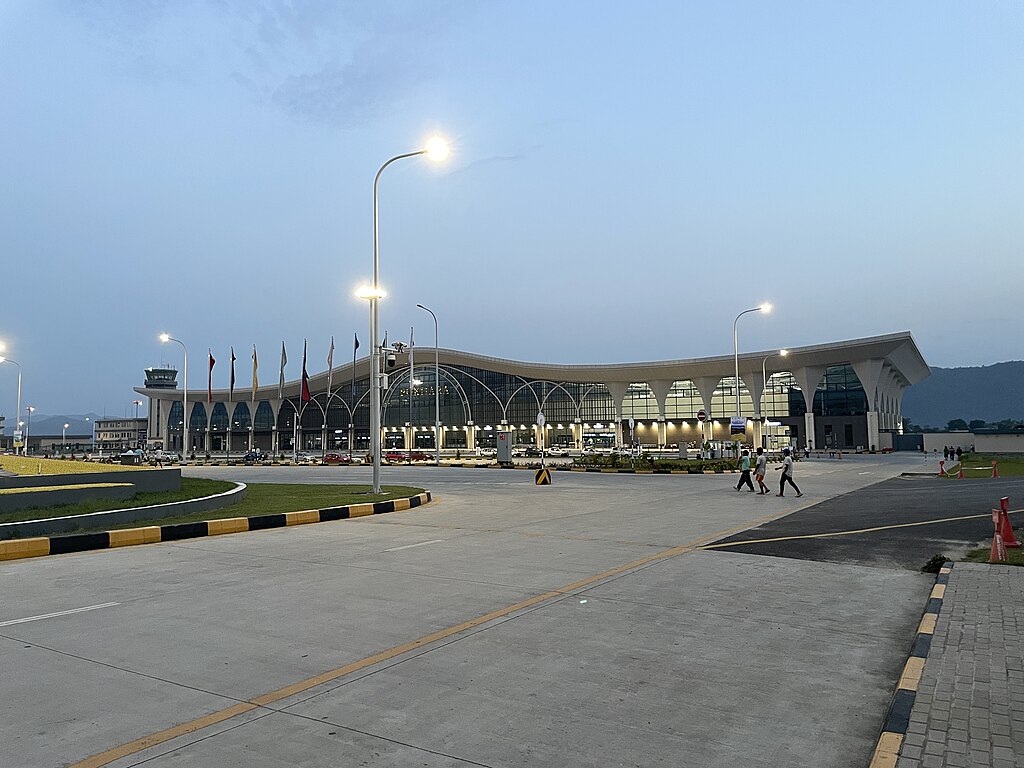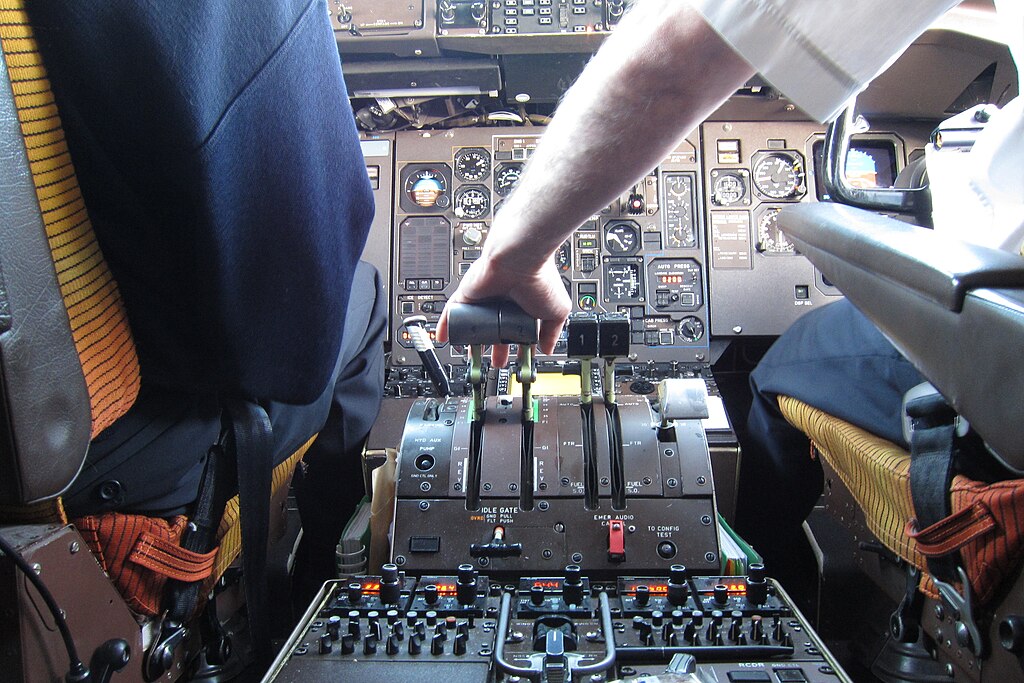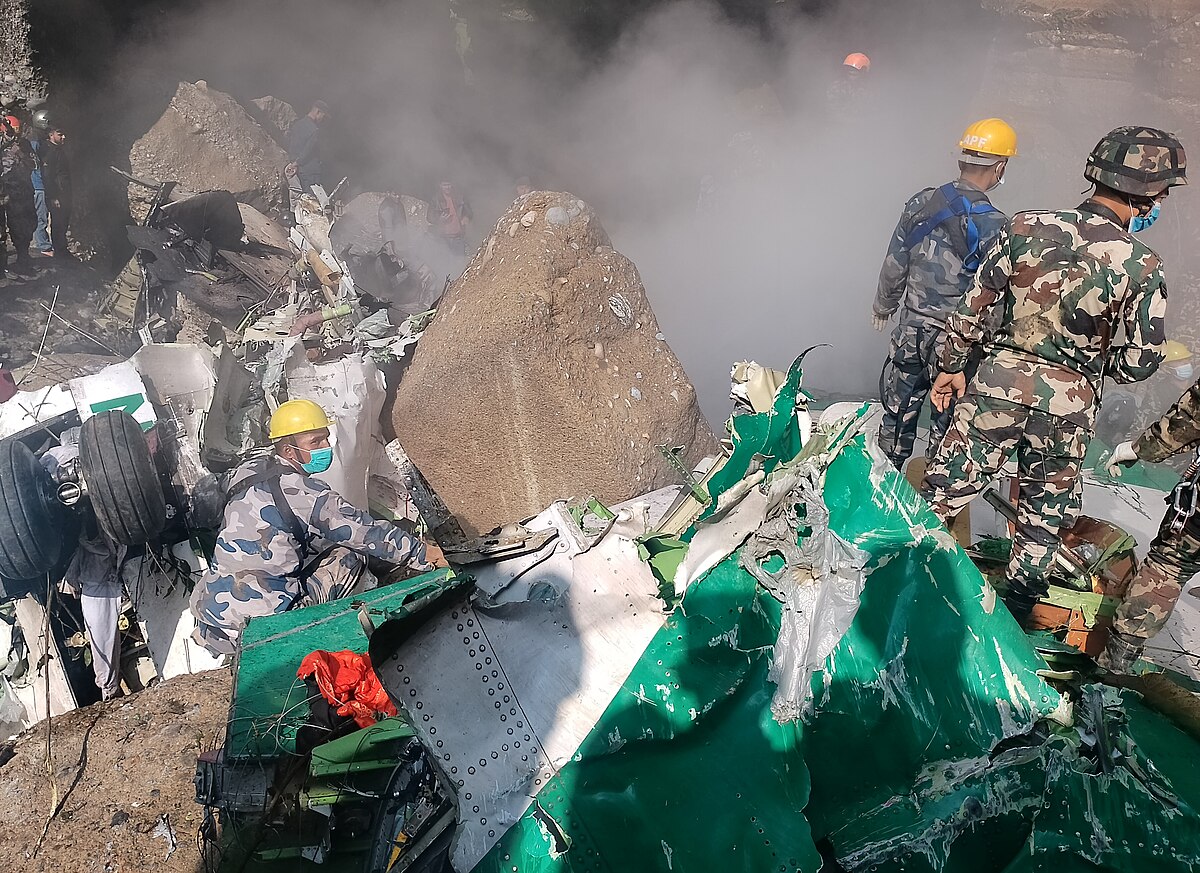Pokhara is a dream of a city for tourists who visit the place. However, in the aviation community, the construction of the Pokhara International Airport (PHH)has led many people to question whether it is a failure. The idea that this airport might be a debt trap set by China is something a lot of people are wondering about. A lack of international operations at PHH has also led many people to wonder if it will fall on the long list of abandoned airports in the nation. The crash of Yeti Airlines Flight 691 that left no survivors was one such incident that added to the woes of this airport, which is the main airport of Pokhara.
Sketches of Yeti Airlines Flight 691 crash

photo: Bhupendra Shrestha | Wikimedia commons
On January 15, 2023, during the Maghesagrati festival, Yeti Airlines’ 9N-ANC aircraft flew from Kathmandu to Pokhara. The weather was clear, and the aircraft received clearance from the ATC tower to land on runway 12. As the aircraft was aligning with the runway, the master caution alarm suddenly rang in the cockpit, but the captain and pilot were unsure of the cause.
Both pilots attempted to determine the reason for the alarm while the aircraft’s speed gradually decreased, despite pushing the thrust to maximum. With the runway approaching and the aircraft unable to maintain speed, it veered off its intended path instead of moving toward the runway. The aircraft began to lean to the left and, within seconds, crashed into the bank of the Seti River. The crash took the lives of the 68 passengers and 4 crew members on board
Yeti Airlines Flight 691: History and background
The aircraft that crashed in Pokhara was an ATR-72 was manufactured on August 1, 2007 AD. Yeti Airlines began its commercial flights 26 years ago, in September 1998, with the DHC-6 Twin Otter aircraft. Heres a brief timeline of the history and purchase:
- first leased by Kingfisher Airlines on August 16, 2007 AD, from Investec Bank.
- The bank began renting the aircraft in September, and on March 8, 2012, Nok Air Thailand started using it.
- Yeti Airlines took the lease from Investec Bank on April 26, 2016 AD, and it was registered as 9N-ANC.
Pokhara International Airport and the first demo flight

Photo:Hariram sigdel |Wikimedia commons
The Exim Bank of China provided a loan of 22 Arba to build Pokhara International Airport. The airport opened on January 1, 2023, and authorities transferred all domestic flights from the old Pokhara Airport to the new international airport. The airport has only one runway, which is 2,500 meters long. Ongoing discussions focus on runway designations, which authorities assign based on orientation and magnetic compass readings.
If an aircraft takes off from the northeast direction, air traffic control designates it as runway 03. If it takes off or lands from the east-south direction, air traffic control designates it as runway 12. For the first time, two airline companies tested their aircraft at this airport they are :
- ATR-72 of Yeti Airlines
- ATR-72 of Buddha Airlines
Yeti Airlines successfully landed on Runway 03, while Buddha Air landed on Runway 12. The first aircraft to land in Pokhara was Yeti Airlines, which was the same aircraft that later crashed. The pilot of that flight was also the same individual who was killed in the accident.
About the pilots of Flight 691
The captain of Yeti Airlines’ 9N-ANC was Kamal KC, and the co-pilot was Anju Khatiwada. Kamal KC had been with the airline for 10 years and had 20 years of flying experience. Anju Khatiwada had 6,500 flying hours and had worked for Yeti Airlines for 13 years.
Anju Khatiwada’s story is somewhat tragic; her husband, Deepak Pokhrel, died in 2006 AD in a Yeti Airlines DHC-6 Twin Otter crash at Jumla Airport. Deepak was the co-pilot on that flight, which was coming from Surkhet when it crashed while landing in Jumla.
After Deepak’s death, Anju’s father intended to send her to India for nursing. However, with her husband’s insurance money, she went to the USA to become a pilot. Anju Khatiwada joined Yeti Airlines in 2010.
A brief dive into aviation vocabulary that might be useful to analyze 691

Photo: Photo: Olivier Cleynen | Wikimedia Commons
In the ATR-72 cockpit, between the two pilots, there are several levers:
- Flap Lever: This lever controls the flaps on the aircraft’s wings. When the crew pulls the flap lever, the flaps extend outward at a specific angle, generating drag. They typically do this during landing to reduce the aircraft’s speed and increase lift, making it easier to land.
- Condition Lever: This lever controls the propeller’s engine activity. When the crew parks the aircraft, they pull the lever down to cut off the fuel. Moving the lever upward engages propeller feathering, while the top position is called auto feathering. Normally, ATR aircraft operate in this condition. When one engine fails, the crew keeps the condition lever for the other engine at 100%; otherwise, they usually set it to auto-feathering.
- Power Lever: Located to the left of the condition lever, this lever controls the engine speed and, consequently, the aircraft’s speed.
- Parking Brake: To the left of the power lever, there is a parking brake.
Yeti Airlines Flight 691: Causes and Analysis
On January 15, 2023, Pilot Kamal KC and co-pilot Anju Khatiwada prepared for their first flight in the morning. The aircraft took off from Tribhuvan International Airport and normally landed on runway 30 at Pokhara International Airport. After completing this flight, the same crew flew from Pokhara to Kathmandu, where the aircraft landed normally.
A few hours later, the same crew prepared to return to Pokhara. The ground team refueled the aircraft, and 68 passengers boarded, bringing the total to 72 people, including 4 cabin crew members. Among the passengers, 53 were Nepalese and 15 were foreigners. The flight attendants included Srijana Hongchun and Osin Ale Magar.
The pilot flying was Anju Khatiwada, meaning she was in control of the aircraft, while Kamal KC was monitoring flight management and cross-checking Anju’s actions, performing supporting duties. Kamal KC sat on the right side of the cockpit, and Anju Khatiwada sat on the left.
Misinformation spread about Anju Khatiwada after this flight, suggesting she would become a captain. However, she was not flying to qualify as a captain; it was merely a familiarization flight for her, after which she would receive clearance to land at the new Pokhara International Airport.
Before taking off, she completed all necessary checks. At 10:32 AM, the flight took off from Tribhuvan Airport, marking their third flight to Pokhara that day. The maintenance team properly maintained the aircraft, and after checking the technical records, they confirmed that it was within the prescribed weight balance.
As the aircraft entered Pokhara’s airspace, the sky was clear, the weather was good, and the mountains were visible. Everything appeared normal, with visibility at 6 km and the runway visible from a distance. The aircraft began its slow descent.
The ATC assigned Yeti Airlines’ 9N-ANC to land on runway 03. However, the pilot requested permission to land on runway 12, which was granted by ATC. Landing on runway 12 was unusual as it required circling the airport. The aircraft then headed toward runway 12, preparing for its first turn while descending.
As the aircraft began to turn left, its altitude decreased by 220 feet in a short time. After 13 seconds, Anju Khatiwada reported that the engine was not providing enough power. She applied full throttle, but the engine still could not generate sufficient thrust. Anju then handed control to Captain Kamal, and the aircraft began to bank left. Suddenly, the aircraft started rolling and crashed into the bank of the Seti River.
Breakdown of Yeti Airlines Flight 691 five minutes before the crash
The landing on runway 12 was divided into three parts – the Downwind leg, the Base leg, and the Approach leg. Let’s take a look at the positions of the aircraft before the crash:
- At 10:51:36, the aircraft descended from 6,500 feet to enter the downwind track.
- 4 minutes and 36 seconds later, at 10:56:12, the flaps were set to 15 degrees.
- At 10:56:27, the aircraft was 721 feet above the ground, and the pilot turned off the autopilot.
- Five seconds later, Pilot Anju called for flap 30, and Pilot Kamal KC, monitoring the flight, asked her to proceed.
Wrong lever pulled
Instead of setting the flaps to 30 degrees, Kamal KC pulled the condition lever down, causing it to enter the feathering state. This was where the mistake occurred.
When the condition lever is pulled into the feathering position, the propeller blades become parallel to the airflow, transitioning from a slanted to a straight position. This feathering position reduces drag, making it easier to maintain the aircraft in the air during engine failure. However, in feathering, the aircraft’s speed will be slower compared to when the propeller is not feathered.
Not taking serious action after master caution
At 10:56:36, four seconds after pulling the condition lever instead of the flap lever, the master caution alarm began to ring, indicating something was wrong with the aircraft. The crew reviewed the pre-landing checklist to identify any issues. However, the flaps were not set to 30 degrees, and the aircraft began a left turn toward its base. At this point, the condition lever was in the feather position, meaning engine thrust was decreasing.
In response, Anju Khatiwada increased the power lever from 41% to 44%, but the propellers feathered, causing the torque of both engines to drop to 0%, and both pilots remained unaware of this. At 10:56:50, the aircraft was 500 feet above the ground, and the crew heard a clicking sound as they continued to investigate the cause of the master caution alarm.
The engines were not generating enough torque, prompting Kamal KC to suggest applying a little power and stating that it wasn’t necessary to descend. At 10:56:54, another clicking sound was produced. Finally, they noticed that the flaps were still at 15 degrees and increased the flap lever to 30 degrees.
The pilots were unaware of the condition lever
They still did not notice that the condition lever was in the feathered position, despite the fact that they should have identified the problem by this time. At 10:57:07, ATC gave clearance for landing, but the crew did not respond because they were still trying to diagnose the issues with the aircraft.
The crew could have saved the aircraft if they had recognized the feathered condition, but they could not identify it at that moment. Anju Khatiwada shouted to the pilot twice that there was no power from the engine. The power lever was increased to 62 degrees, and when that had no effect, it was set to the maximum position. The aircraft was at the end of the base leg, at 368 feet above ground level, and initiating a left turn.
However, sufficient thrust was still not being generated. At 10:57:18, Anju Khatiwada handed control of the aircraft to Kamal KC. A few seconds later, she again reported that there was no power from the engine. By this time, the aircraft should have been landing but had already veered off course.
At 10:57:24, the aircraft was just 311 feet above the ground, and the stick shaker activated as the first warning, indicating insufficient engine power. Two seconds later, at 10:57:26, the second stick shaker activated, and the aircraft suddenly leaned to the left, slowly rolled, and crashed into the gorge of Seti River.
Casualties and post-crash activities

Photo: Bhupendra Shrestha | Wikimedia Commons
In this crash, all 72 people on board, including 68 passengers and 4 flight crew members, died due to the impact. The aircraft was completely destroyed, and all parts were burning. Several witnesses observed the accident.
The aircraft fell into a gorge where firefighters could not reach, making it difficult to control the fire. The gorge on the bank of the Seti River was about 300 meters deep, complicating rescue efforts. The holiday crowd further hindered the situation. Various organizations, including ICAO, published reports on the accident.
Probable cause and contributory factors of the crash
The most likely cause of the accident was the unintentional movement of both condition levers to the feathered position during flight. This was the first and the only crash related to ATR 72 in the nation. This caused both propellers to feather, resulting in a loss of thrust, which led to an aerodynamic stall and a collision with the terrain. Here are some contributing factors to the accident, as reported by the Aviation Safety Network:
- The crew faced a high workload while operating at a new airport with challenging terrain, which caused them to miss important flight deck and engine indications that both propellers had been feathered
- Human factors such as high workload and stress contributed to the crew misidentifying and incorrectly selecting the propellers to the feathered position.
- The need to navigate a tight circuit to land on runway 12, which was not the usual visual circuit pattern, increased the crew’s workload. This tight pattern also meant that the approach did not meet the criteria for a stabilized visual approach.
- The team responsible for the visual approach circuit for runway 12 used it without proper evaluation, validation, or resolution of its associated risks. The Safety Risk Management (SRM) team of CAAN highlighted these risks, along with recommendations from a flight procedures design report by a consultant. Additionally, the operator and regulator did not develop or approve the approach chart.
- The crew lacked adequate technical and skill-based training (including simulator training) and did not receive proper classroom briefings for safely operating flights at the new airport, particularly for the visual approach to runway 12.
- There was non-compliance with Standard Operating Procedures (SOPs), ineffective Crew Resource Management (CRM), and a lack of sterile cockpit discipline.
